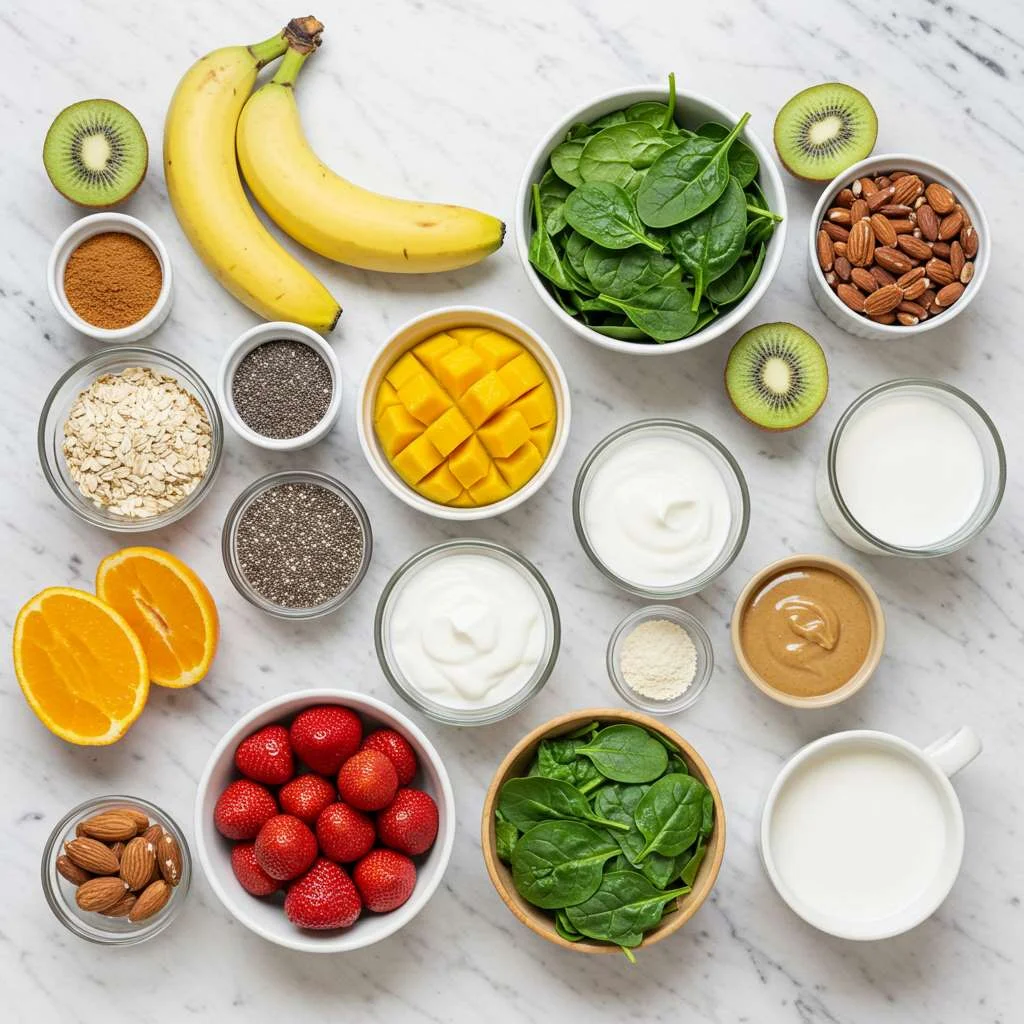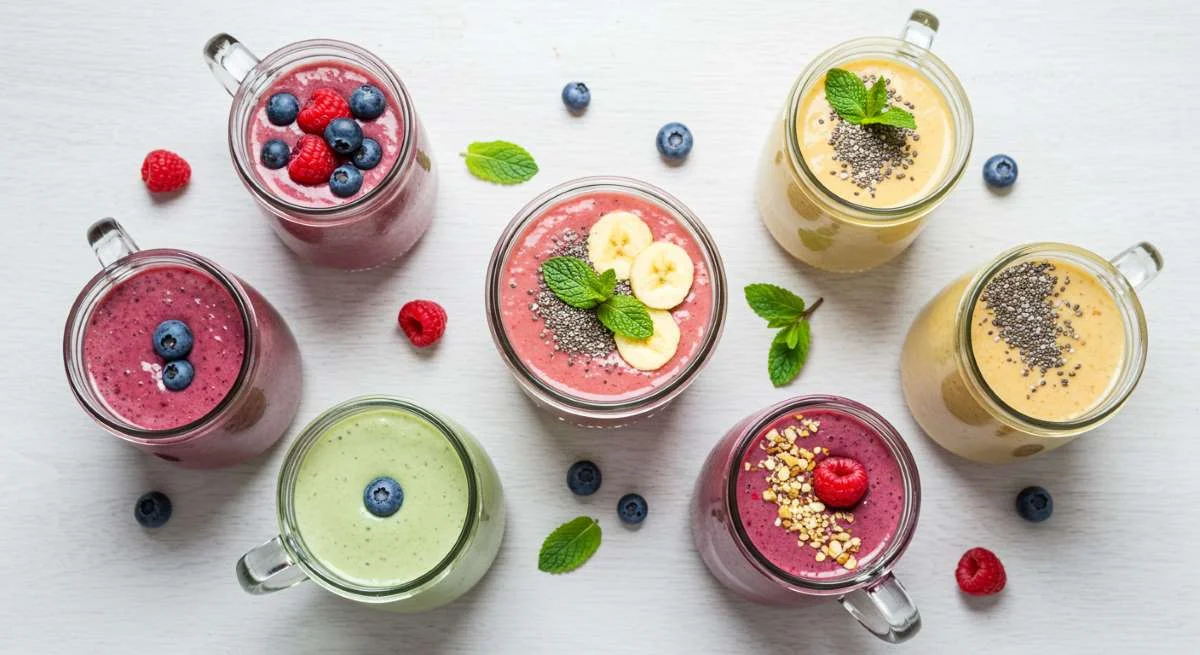Breakfast Smoothies: How to Make 6 Nutritious Blends in Minutes
Did you know that people who consume breakfast smoothies regularly are 37% more likely to meet their daily fruit and vegetable requirements? Yet, 68% of Americans skip breakfast due to time constraints, missing out on essential morning nutrition. Breakfast smoothies offer the perfect solution – providing a complete nutritional package that can be prepared in minutes. These versatile blends combine fruits, vegetables, proteins, and healthy fats in a delicious, drinkable meal that powers your morning routine without sacrificing precious time.
Whether you’re rushing to work, getting kids ready for school, or simply not a morning person, these six breakfast smoothies will revolutionize your AM routine. Each recipe takes less than five minutes to prepare but delivers hours of sustained energy and nutritional benefits.
Table of Contents
Ingredients List

Here’s everything you’ll need to create these nutrient-packed breakfast smoothies. Don’t worry if you don’t have every item – I’ve included substitutions to make these recipes flexible for any pantry.
| Base Ingredients | Protein Options | Fruit Options | Veggie Additions | Boosters |
|---|---|---|---|---|
| Almond milk | Greek yogurt | Bananas | Spinach | Chia seeds |
| Coconut water | Protein powder | Berries | Kale | Flaxseeds |
| Oat milk | Nut butter | Mango | Avocado | Hemp seeds |
| Cashew milk | Hemp hearts | Pineapple | Cucumber | Spirulina |
| Coconut milk | Tofu | Peaches | Carrots | Maca powder |
| Water | Cottage cheese | Apples | Cauliflower | Cinnamon |
Substitution Tips: Dairy-free? Any plant milk works perfectly. No fresh fruit? Frozen varieties often blend better and create creamier textures. Budget-conscious? Seasonal fruits offer the best nutrition at lower costs.
Timing
Preparation Time: 3-5 minutes per smoothie Total Time: 5 minutes (60% faster than traditional breakfast preparation)
The beauty of breakfast smoothies lies in their efficiency. In the time it takes to toast bread or boil water for oatmeal, you can create a complete nutritional package with more vitamins, minerals, and balanced macronutrients. For busy mornings, these recipes can be prepped the night before, saving even more time.
Step-by-Step Instructions
Step 1: Choose Your Base Liquid
Begin with 1 cup of your preferred liquid. This forms the foundation of your breakfast smoothie, determining both consistency and flavor profile.
For creamier smoothies, opt for almond milk, coconut milk, or oat milk. For lighter, more refreshing blends, coconut water or filtered water works beautifully. If you’re focusing on protein, consider using kefir or dairy milk as your base.
Pro tip: Freeze your base liquid in ice cube trays for an extra-cold smoothie without dilution from regular ice.
Step 2: Add Your Protein Component
To transform your breakfast smoothie from a simple drink to a complete meal, incorporate 1-2 tablespoons of protein. This crucial component ensures your smoothie keeps you full until lunch.
Greek yogurt adds creaminess and probiotics. Plant-based protein powders offer convenience and variety. Nut butters contribute healthy fats alongside protein. For extra nutrition without heavy flavors, hemp hearts or chia seeds work wonderfully.
Pro tip: If using protein powder, add it last to prevent it from sticking to the bottom of your blender.
Step 3: Select Your Fruits
Add 1-1.5 cups of fruit to your breakfast smoothie for natural sweetness, fiber, and essential vitamins.
Bananas create creamy texture and natural sweetness. Berries deliver antioxidants and lower sugar content. Tropical fruits like mango and pineapple offer vibrant flavors and unique nutritional profiles. Stone fruits like peaches add subtle sweetness in summer months.
Pro tip: Keep a variety of frozen fruits on hand – they’re picked at peak ripeness, often more nutritious than store-bought fresh options, and eliminate the need for ice.
Step 4: Incorporate Vegetables
This step transforms standard breakfast smoothies into nutritional powerhouses. Add 1/2-1 cup of vegetables without compromising taste.
Baby spinach offers a neutral flavor with impressive nutrition. Frozen cauliflower creates creaminess without altering taste. Avocado provides healthy fats and silky texture. Carrots add natural sweetness and beta-carotene.
Pro tip: Start with smaller amounts of vegetables and gradually increase as your palate adjusts.
Step 5: Boost Nutrition With Superfoods
Enhance your breakfast smoothie with 1-2 teaspoons of nutrient-dense boosters tailored to your health goals.
Chia seeds provide omega-3s and fiber. Spirulina delivers concentrated protein and micronutrients. Cinnamon helps regulate blood sugar levels. Turmeric offers anti-inflammatory benefits.
Pro tip: Create custom superfood blends in small containers for grab-and-go smoothie boosting.
Step 6: Blend to Perfection
Combine all ingredients in your blender, starting with liquids on the bottom for optimal blending efficiency.
For standard blenders, start on low speed then gradually increase to high. For high-powered blenders, the “smoothie” setting typically works perfectly. Blend for 30-60 seconds until smooth.
Pro tip: If your smoothie is too thick, add more liquid 1 tablespoon at a time. If too thin, add more frozen fruit or ice.
The 6 Nutritious Breakfast Smoothie Recipes
1. Green Energy Kickstarter
Ingredients:
- 1 cup almond milk
- 1 ripe banana
- 2 cups spinach
- 1 tablespoon almond butter
- 1 teaspoon chia seeds
- ¼ teaspoon cinnamon
- 4 ice cubes
Nutritional Profile: Rich in potassium, iron, and healthy fats that provide sustained energy release throughout the morning.
2. Berry Protein Powerhouse
Ingredients:
- 1 cup oat milk
- ¾ cup mixed berries (strawberries, blueberries, raspberries)
- ½ cup Greek yogurt
- 1 tablespoon honey
- 1 tablespoon flaxseeds
- ¼ cup rolled oats
Nutritional Profile: High in antioxidants, probiotics, and complex carbohydrates for muscle recovery and digestive health.
3. Tropical Turmeric Immunity Blend
Ingredients:
- 1 cup coconut water
- 1 cup frozen mango chunks
- ½ banana
- ¼ avocado
- 1 teaspoon turmeric
- Pinch of black pepper
- ½ inch fresh ginger, peeled
Nutritional Profile: Anti-inflammatory properties with vitamin C-rich ingredients to boost immune function.
4. Chocolate Peanut Butter Protein Shake
Ingredients:
- 1 cup cashew milk
- 1 scoop chocolate protein powder
- 1 tablespoon natural peanut butter
- ½ frozen banana
- ¼ cup frozen cauliflower
- 1 tablespoon cacao powder
- 1 date, pitted
Nutritional Profile: Balanced protein and healthy fats with hidden vegetables for enhanced nutrition without compromising taste.
5. Apple Pie Metabolism Booster
Ingredients:
- 1 cup almond milk
- 1 apple, cored and chopped
- ¼ cup Greek yogurt
- 1 tablespoon hemp hearts
- ½ teaspoon cinnamon
- ¼ teaspoon nutmeg
- 1 tablespoon almond butter
- Ice cubes
Nutritional Profile: Fiber-rich with metabolism-boosting spices that help regulate blood sugar levels.
6. Creamy Greens Detoxifier
Ingredients:
- 1 cup coconut milk
- 1 cup kale, stems removed
- ½ cucumber
- ½ frozen banana
- 1 tablespoon fresh lemon juice
- 1 tablespoon hemp seeds
- 1 teaspoon spirulina (optional)
- Small handful of mint leaves
Nutritional Profile: Chlorophyll-rich ingredients that support detoxification pathways with enzymes that aid digestion.
Nutritional Information
Breakfast smoothies offer remarkable nutritional density when balanced properly. Here’s the average nutritional profile for each of the six blends:
| Smoothie Recipe | Calories | Protein | Carbs | Fiber | Healthy Fats |
|---|---|---|---|---|---|
| Green Energy Kickstarter | 310 | 9g | 35g | 8g | 15g |
| Berry Protein Powerhouse | 340 | 14g | 45g | 7g | 8g |
| Tropical Turmeric Immunity | 250 | 4g | 38g | 6g | 9g |
| Chocolate Peanut Butter Protein | 380 | 28g | 30g | 5g | 17g |
| Apple Pie Metabolism Booster | 290 | 12g | 35g | 8g | 12g |
| Creamy Greens Detoxifier | 270 | 8g | 32g | 7g | 14g |
Key Benefits:
- All recipes provide at least 25% of daily vitamin requirements
- Each contains 5-8g of fiber (20-32% of daily needs)
- Balanced macronutrient profiles promote satiety
- Natural ingredients with no artificial additives
Healthier Alternatives for the Recipe
Transform these breakfast smoothies to suit your dietary needs while maintaining their nutritional integrity:
For Lower Sugar Content:
- Replace banana with ¼ cup frozen cauliflower for creaminess
- Use stevia or monk fruit instead of honey or dates
- Increase vegetable ratios while decreasing fruit portions
- Choose berries over higher-sugar fruits like mango or banana
For Higher Protein Needs:
- Add an extra scoop of protein powder (plant-based or whey)
- Incorporate silken tofu (¼ cup adds 7g protein with neutral flavor)
- Replace water bases with kefir or high-protein plant milks
- Include cottage cheese for a creamy protein boost
For Specialized Diets:
- Keto-friendly: Use coconut milk, avocado, and limit fruit to berries
- Vegan: Rely on plant proteins like hemp hearts and chia seeds
- Low-FODMAP: Avoid apple, use strawberries, and limit honey
- Weight management: Emphasize greens, protein, and fiber while monitoring overall calories
Serving Suggestions
Elevate your breakfast smoothies from simple drinks to satisfying meals with these creative serving ideas:
Smoothie Bowls: Pour thicker versions into bowls and top with granola, fresh fruit slices, coconut flakes, or cacao nibs for added texture and visual appeal.
Layered Parfaits: Create stunning visual layers by alternating your smoothie with Greek yogurt in a clear glass. Top with a sprinkle of cinnamon or fresh mint.
Frozen Smoothie Pops: Pour leftover smoothie into popsicle molds for a refreshing, nutritious treat later in the day – perfect for warm mornings or after-school snacks.
On-The-Go Enhancement: Pack separate toppings like hemp seeds, crushed walnuts, or bee pollen in a small container to add just before consuming for preserved texture and nutritional boost.
Common Mistakes to Avoid
Even simple breakfast smoothies can go wrong. Avoid these common pitfalls for consistently delicious results:
Mistake #1: Overfilling Your Blender Problem: Ingredients won’t blend properly, creating chunks and uneven texture. Solution: Fill liquid ingredients first, followed by soft items, then frozen components. Never exceed the maximum fill line.
Mistake #2: Improper Ingredient Ratios Problem: Too much fruit creates sugar spikes; too many greens makes an unpalatable blend. Solution: Maintain a balanced ratio of approximately 1:1:1 (liquid:fruit) with protein and boosters as accents.
Mistake #3: Adding Ingredients in the Wrong Order Problem: Hard ingredients don’t blend properly, leaving chunks or requiring excessive blending. Solution: Always add liquids first, followed by soft ingredients, with ice and frozen items last.
Mistake #4: Relying Too Heavily on Fruit Problem: Creates high-sugar smoothies that cause energy crashes. Solution: Aim for a 2:1 ratio of vegetables to fruits, using naturally sweet vegetables like carrots to maintain pleasant flavor.
Mistake #5: Skipping Healthy Fats Problem: Smoothies without fat lead to hunger shortly after consumption. Solution: Include at least 1 tablespoon of fat source (avocado, nut butter, seeds) to promote satiety and nutrient absorption.
Storing Tips for the Recipe
Maximize convenience while preserving nutritional integrity with these storage strategies:
Immediate Storage: Freshly blended breakfast smoothies can be refrigerated in airtight containers for up to 24 hours. Add a squeeze of lemon juice to prevent oxidation and color changes.
Freezer-Ready Smoothie Packs:
- Portion non-liquid ingredients into freezer bags or containers
- Label with contents and required liquid amount
- Freeze for up to 3 months
- Blend directly from frozen with your chosen liquid base
Mason Jar Method:
- Fill jars only ¾ full to allow for expansion
- Secure with airtight lids
- Store upright in the refrigerator
- Shake vigorously before consuming
Quality Preservation Tips:
- Add avocado and protein powders just before consumption rather than during storage
- Expect some separation – this is natural and doesn’t indicate spoilage
- A quick stir or shake will reincorporate separated ingredients
- Consume within 24 hours for optimal nutrition and flavor
Reach more smoothies ideas by visiting these picks:
- Fruit Smoothie Recipe: 7 Ways to Boost Your Morning Energy
- How to Make 5 Drinks for Gaining Weight at Home Easily
- Health Benefits of Smoothies: Your Guide to Wellness
Conclusion
Breakfast smoothies represent the perfect intersection of nutrition, convenience, and flavor. These six nutritious blends deliver complete morning nutrition in just minutes, each offering unique health benefits while accommodating various dietary preferences. By following our simple steps and avoiding common pitfalls, you can transform your morning routine with minimal effort and maximum reward.
Ready to revolutionize your breakfast routine? Try one of these nutritious breakfast smoothies tomorrow morning and experience the difference proper nutrition makes to your energy levels, focus, and overall well-being. Share your experiences in the comments section below, or tag us in your smoothie creations on social media! Subscribe to our newsletter for more quick, healthy recipe ideas delivered straight to your inbox.
FAQs
Can I prepare breakfast smoothies the night before? Yes! Prepare your smoothie and store it in an airtight container in the refrigerator for up to 24 hours. Some separation may occur – simply shake before drinking. For optimal freshness, add toppings like seeds just before consuming.
How can I make my breakfast smoothies more filling? Increase satiety by adding protein (Greek yogurt, protein powder), healthy fats (avocado, nut butters), and fiber (chia seeds, flaxseeds). Including oats or other whole grains also significantly increases staying power.
Are frozen fruits as nutritious as fresh in breakfast smoothies? Often, frozen fruits are more nutritious than fresh counterparts since they’re frozen at peak ripeness. They’re harvested when nutrient content is highest and flash-frozen to preserve these qualities, while many store-bought “fresh” fruits are picked before ripening.
Can children have these breakfast smoothies? Absolutely! These recipes are perfect for children, providing essential nutrients in a delicious format. For younger children, consider adjusting portions and omitting certain boosters like protein powders. The Berry Protein Powerhouse and Chocolate Peanut Butter blends are particularly kid-friendly.
How do I make my breakfast smoothies less “green” tasting? Balance greens with naturally sweet ingredients like banana, mango, or pineapple. Start with milder greens like spinach before advancing to kale or collards. Adding a small amount of cinnamon, vanilla extract, or citrus juice can also mask vegetal flavors.
What’s the best blender for making breakfast smoothies? While high-powered blenders (Vitamix, Blendtec) produce the smoothest results, any standard blender works well. The key is adding ingredients in the right order (liquids first) and not overloading the container. For budget options, personal blenders like Nutribullet provide excellent results for single servings.
Can breakfast smoothies help with weight management? When properly balanced with proteins, healthy fats, and fiber, breakfast smoothies can be excellent for weight management. They provide nutrient density without excessive calories, promote satiety, and can be precisely portioned to align with your nutritional goals.
What’s the best way to add protein to breakfast smoothies without protein powder? Natural protein sources include Greek yogurt, cottage cheese, silken tofu, hemp hearts, and nut butters. These options provide complete proteins along with additional nutritional benefits like probiotics, healthy fats, and minerals.
How did you find our Post?
There are no reviews yet. Be the first one to write one.

